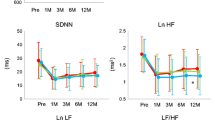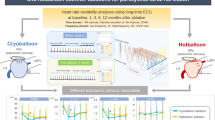Abstract
To determine the relation between the creation of endocardiallesions and alterations in autonomic tone, we analyzed heart ratevariability in patients undergoing radiofrequency catheter ablation forsymptomatic supraventricular tachycardia.
Elevated heart rates are frequently noted after radiofrequency catheterablation for supraventricular arrhythmias. It has been postulated that thiselevation may be secondary to alterations in cardiac autonomic tone. Sinceheart rate variability is a measure of autonomic nervous system activity, weused this technique to examine the heart rate elevation and to characterizepostablation autonomic changes.
Thirty-eight patients undergoing 44 radiofrequency catheter ablationprocedures were included in the study. Total arrhythmic substrates treatedincluded 34 accessory pathways and 13 AV nodes with dual physiology.Twenty-four-hour ambulatory electrocardiographic recordings were obtained ina drug-free state prior to, ablation early postablation, and latepostablation. Spectral and nonspectral analyses of heart rate variabilitywere performed. Subgroup analyses were also done on specific cohorts.Subgroups included patients undergoing accessory pathway ablations, AV nodemodifications, and ablation of septal and nonseptal targets. To determinewhether the amount of tissue damage was related to changes in heart ratevariability, we analyzed the relation between the total energy delivered tothe endocardium and the peak change in creatine kinase and heart ratevariability.
In this population, a significant transient increase in heart rate wasnoted following radiofrequency ablation. All time and frequency domainparameters of heart rate variability showed significant reversibledecreases. These changes were independent of target site and arrhythmiasubstrate. There was no correlation noted between the changes in heart ratevariability and either the total amount of energy applied to the endocardiumor the change in creatine kinase.
Increased heart rates and decreased heart rate variability occurfollowing radiofrequency catheter ablation for supraventricular tachycardia. Clinically, the predominant effect is that of decreased parasympathetic tone. Since these transient changes are independent ofarrhythmic substrate or ablation site in the atria, a rich parasympathetic innervation of the heart is proposed.
Similar content being viewed by others
References
Wu D, Denes P. Mechanisms of paroxysmal supraventricular tachycardia. Arch Intern Med 1975;135:437–442.
Josephson ME, Kastor JA. Supraventricular tachycardia: mechanisms and management. Ann Intern Med 1977;87:346–358.
Josephson ME. Paroxysmal supraventricular tachycardia: an electrophysiologic approach. Am J Cardiol 1978;41:1123–1126.
Zipes DP, DiMarco JP, Gillette PC, et al. Guidelines for clinical intracardiac electrophysiological and catheter ablation procedures. A report of the American College of Cardiology/ American Heart Association Task Force on practice guidelines (Committee on Clinical Intracardiac Electrophysiologic and Catheter Ablation Procedures), developed in collaboration with the North American Society of Pacing and Electrophysiology. J Am Coll Cardiol 1995;26:555–573.
Fisher JD, Cain ME, Ferdinand KC, et al. Catheter ablation for cardiac arrhythmias: clinical applications, personnel and facilities. J Am Coll Cardiol 1994;24:828–833.
Scheinman MM. Catheter ablation for cardiac arrhythmias, personnel and facilities (NASPE Policy Statement). PACE 1992;15:715–21.
Ehlert FA, Goldberger JJ, Brooks R, et al. Persistent inappropriate sinus tachycardia after radiofrequency current catheter modification of the atrioventricular node. Am J Cardiol 1992;69:1092–1095.
Kocovic DZ, Harada T, Shea J, et al. Alterations of heart rate and of heart rate variability after radiofrequency catheter ablation of supraventricular tachycardia. Delineation of parasympathetic pathways in the human heart. Circulation 1993;88(4, Part 1):1671–1681.
Swartz JF, Tracy CM, Fletcher RD. Radiofrequency endocardial catheter ablation of accessory pathway atrial insertion sites. Circulation 1993;87:487–499.
Lee MA, Morady F, Kadish A, et al. Catheter modification of the atrioventricular junction with radiofrequency energy for control of atrioventricular nodal reentry tachycardia. Circulation 1991;83:827–835.
Jazayeri MR, Hempe SL, Sra JS, et al. Selective transcatheter ablation of the fast and slow pathways using radiofrequency energy in patients with atrioventricular nodal reentrant tachycardia. Circulation 1992;85:1318–1328.
Jackman WM, Beckman KJ, McClelland JH, et al. Treatment of supraventricular tachycardia due to atrioventricular nodal reentry by radiofrequency catheter ablation of slow-pathway conduction. N Engl J Med 1992;327:313–318.
Malik M, Camm AJ. Components of heart rate variability—what they really mean and what we really measure. Am J Cardiol 1993;72:821–822.
Stein KS, Bosner MB, Kleiger RE, et al. Heart rate variability: a measure of cardiac autonomic tone. Am Heart J 1994;127:1376–1381.
Pagani M, Lombardi F, Malliani A. Heart rate variability: disagreement on the markers of sympathetic and parasympathetic activities (letter). J Am Coll Cardiol 1994;22:951–1952.
Akselrod S, Gordon FA, Ubel FA, et al. Power spectrum analysis of heart rate fluctuation: a quantitative probe of beat-to-beat cardiovascular control. Science 1981;213:220–222.
Pomeranz B, MacAulay RJB, Caudill MA, et al. Assessment of autonomic function in humans by heart rate spectral analysis. Am J Physiol 1985;248:H151–H153. ***ia]18._Task Force of the European Society of Cardiology and the North American Society of Pacing and Electrophysiology}. Heart rate variability, standards of measurement, physiological interpretation, and clinical use. Circulation 1996;93:1043–1065.
Kleiger RE, Miller JP, Bigger T, Moss A. Decreased heart rate variability and its association with increased mortality after acute myocardial infarction. Am J Cardiol 1987;59:256–262.
Van Hoogenhuyze D, Martin GJ, Weiss JS, Schaad J, Fintel D, Singer DH. Heart rate variability 1989: an update. J Electrocardiol 1989;22:204–208.
Frey R, Heinz G, Kreiner G, et al. Increased heart rate variability after radiofrequency ablation. Am J Cardiol 1993;71:1460–1461.
Vitullo RN, Bacon ME, Barrington WL, et al. Scintigraphic comparison of perfusion and sympathetic innervation abnormalities after radiofrequency and surgical ablation of accessory pathways (abstract). J Am Coll Cardiol 1992;19:271A.
Malik M, Camm AJ. Electrophysiology, pacing and arrhythmia. Heart rate variability. Clin Cardiol 1990;13:570–576.
Pürerfellner H, Mascherbauer R, Nesser HJ. Absence of significant changes in heart rate variability after slow-pathway ablation of AV-nodal reentrant tachycardia using serial Holter recordings (abstract). PACE 1995;18:932.
Kent KM, Epstein SE, Cooper T, et al. Cholinergic innervation of the canine and human ventricular conducting system. Anatomic and electrophysiologic correlations. Circulation 1974;50:948–955.
Coumel P, Maison-Blanche P, Catuli D. Heart rate and heart rate variability in normal young adults. J Cardiovasc Electrophysiol 1994;5:899–911.
Katona PG, Jih F. Respiratory sinus arrhythmia: a noninvasive measure of parasympathetic cardiac control. J Appl Physiol 1975;39:801–805.
Author information
Authors and Affiliations
Rights and permissions
About this article
Cite this article
Verdino, R.J., Tracy, C.M., Solomon, A.J. et al. Alterations in Heart Rate Following Radiofrequency Ablation in the Treatment of Reentrant Supraventricular Arrhythmias: Relation to Alterations in Autonomic Tone. J Interv Card Electrophysiol 1, 145–151 (1997). https://doi.org/10.1023/A:1009759200219
Issue Date:
DOI: https://doi.org/10.1023/A:1009759200219




